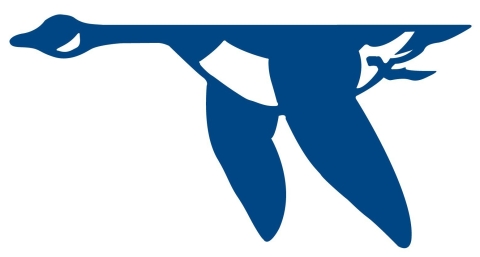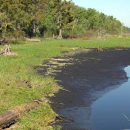Visit Us
The 27,190-acre refuge contains some of the last remaining marsh areas adjacent to Lake Pontchartrain and Lake Borgne and is a great place to enjoy wildlife.
Activities
Visitors are welcome on the refuge seven days a week, during daylight hours. The refuge is closed at night. Bayou Sauvage National Wildlife Refuge is rich in wildlife and in recreation opportunities. It is a popular place to enjoy fishing, crabbing, hiking, paddling, bird watching, nature photography, youth waterfowl hunting, self-guided tours, and interpretive and educational programs.
Wildlife biologist and author Rachel Carson said to watch for "the sign of the flying goose - the emblem of the National Wildlife Refuge System. Wherever you meet this sign, respect it. It means that the land behind the sign has been dedicated by the American people to preserving, for themselves and their children, as much of our native wildlife as can be retained along with our modern civilization."
Certain regulations are necessary for the protection of wildlife and wildlife habitat, and for the safety of visitors. Observance of these rules will help make the refuge a better place for you and the wildlife you enjoy. Learn more here.
Be safe and have fun!
Trails
The Ridge Trail
This ½ mile long looped interpretive boardwalk trail winds through a forest and wetland area with views of the historic Bayou Sauvage waterway and an overlook of a marsh. The forest along this trail was heavily impacted by hurricanes and volunteers are restoring it by planting native trees and Louisiana iris. Interpretive signs tell the story of this restoration and feature natural history. This site has restrooms and a picnic pavilion. Take a virtual Google Earth tour of the Ridge Trail Interpretive Boardwalk trail
From Slidell: Take I-10 west. At the end of the I-10 twin span bridge over Lake Ponchartrain, take Irish Bayou #254/Hwy 11 exit. Turn left onto Highway 11. (The Refuge is on both sides of Highway 11 once you pass through the hurricane protection levee). At the Hwy 11 and Hwy 90/Chef Menteur Hwy intersection turn right and travel two miles to reach the Ridge Trail entrance on the right.
From New Orleans: Take I-10 east to exit #246A (Chalmette, I-510); go about 2 miles south on I-510 to Highway 90 East exit; turn left onto Hwy 90, and go approximately 4 miles to reach the Ridge Trail access on the left.
Joe Madere Marsh
You'll find a canoe launch, a picnic pavilion, and a short boardwalk that leads to a marsh overlook. This is a good place to look for shorebirds, alligators, and waterfowl. The waterway is silted in, most times of year paddling is no longer possible here. Take a virtual Google Earth tour of the Joe Madere site
GPS coordinates: 30° 3’ 13” N 89° 52’ 35” W
From Slidell: Take I-10 west. At the end of the I-10 twin span bridge over Lake Ponchartrain, take Irish Bayou #254/Hwy 11 exit. Turn left onto Highway 11. (The Refuge is on both sides of Highway 11 once you pass through the hurricane protection levee). At the Hwy 11 and Hwy 90/Chef Menteur Hwy intersection turn right and travel 1.7 miles to reach the entrance on the left.
From New Orleans: Take I-10 east to exit #246A (Chalmette, I-510); go about 2 miles south on I-510 to Highway 90 East exit; turn left onto Hwy 90, and go approximately 4.3 miles to reach entrance on your right.
Crabbing Bridge Road
This popular fishing and crabbing area is located at the south end of the old Hwy 11 bridge over Lake Ponchartrain. An unpaved 1.4 mile dirt road leads to a closed-to-traffic bridge over Little Irish Bayou. GPS coordinates: 30° 9’ 14.50” N 89° 51’ 25.9” W
From Slidell: Take I-10 west. At the end of the I-10 twin span bridge over Lake Ponchartrain, take Irish Bayou #254/Hwy 11 exit. Carefully turn left to access the frontage road that runs between the lake and the westbound interstate ramp. Follow this dirt road 1.4 miles to reach the old bridge over Irish Bayou.
From New Orleans: Take I-10 east to the Irish Bayou/Hwy 11 exit. Turn left onto Hwy 11 and follow Hwy 11 across the I-10 overpass. Carefully turn left to access the frontage road that runs between the lake and the westbound interstate ramp. Follow this dirt road 1.4 miles to reach the old bridge over Irish Bayou.
Hwy 11 Boat Launch
This launch with a small fishing pier provides access to a canal leading to Lake Maisson and Lake Antoine. GPS coordinates: 30° 7’ 7” N 89° 52’ 00” W
From Slidell: Take I-10 west. At the end of the I-10 twin span bridge over Lake Ponchartrain, take Irish Bayou #254/Hwy 11 exit. Travel approximately 2.5 miles south on Hwy 11 to reach boat launch on the right.
From New Orleans: Take I-10 east to exit #246A (Chalmette, I-510); go about 2 miles south on I-510 to Highway 90 East exit; turn left onto Hwy 90, following it to the Hwy 11 intersection. Turn left from Hwy 90 onto Hwy 11 and travel 3 miles to reach the boat launch on the left.
Related Documents
Other Facilities in the Complex
Bayou Sauvage Urban National Wildlife Refuge is managed as part of the Bayou Sauvage Urban National Wildlife Refuges Complex. The National Wildlife Refuges in Southeast Louisiana are part of a rich ecological system which includes marshes, pine and bottomland hardwood forests, lakes, barrier islands, swamps and bayous. Ranging from the marshy delta at the mouth of the Mississippi, to the wetlands that help protect New Orleans from hurricanes and provide a nursery to the fisheries that support the region’s food economy, to the wild bayous of the Atchafalaya Basin; your Southeast Louisiana National Wildlife Refuges preserve wildlife, habitat, and recreation opportunities representative of this unique part of the country.
All of the Southeast Louisiana National Wildlife Refuges are open to public visits for nature-based recreational enjoyment. Priority public uses are hunting, fishing, wildlife observation, wildlife photography, environmental education, and interpretation.
The refuge complex headquarters is located at 61389 Hwy 434, Lacombe, Louisiana 70445. This site also hosts the Bayou Lacombe Visitor Center and has walking trails that wind through an historic garden site and along Bayou Lacombe.
Rules and Policies
Refuge Hours
Visitors are welcome at the refuge during daylight hours only. The refuge is closed at night.
Hiking
Hiking is allowed on refuge trails and levees. Please note: For safety reasons, all areas of the refuge located outside the Hurricane Protection Levee are closed to public entry until after 12 noon from November 1 – January 31, and during the state teal season, except for youth waterfowl hunting which is allowed until 12 noon.
Closures
Occasionally, areas within refuge boundaries may be closed to public entry due to construction, maintenance or restoration activities. Be aware of signs indicating closed areas. Pay special attention at gates and other points of entry to determine if the area is open. All areas of the refuge located outside the Hurricane Protection Levee are closed to public entry other than youth waterfowl hunting until 12 noon from November 1 – January 31, and during the state teal season.
Dogs
Dogs are allowed on the refuge. They must be kept on a leash, except dogs engaged in authorized youth waterfowl hunting activities. The use of dogs is permitted only to locate, point, and retrieve while hunting.
Bicycles
Biking is allowed on the Maxent Levee located at the Ridge Trail site, as well as on dirt roads and levees.
Hunting
Youth waterfowl hunting is permitted on designated areas of the refuge in accordance with state regulations. Refer to the Bayou Sauvage National Wildlife Refuge Hunting and Fishing Regulations brochure for more information. A signed copy of this publication serves as a permit to hunt on the refuge.
Fishing
Sport fishing and shell fishing are permitted year-round in accordance with state regulations inside the Hurricane Protection Levee, and permitted only after 12 p.m. outside the levee during the state teal season and from November 1 – January 31. Refer to the Bayou Sauvage National Wildlife Refuge Hunting and Fishing Regulations brochure for more information.
Drones
Wildlife, and even endangered species— can be negatively affected by drone flights. It is illegal to operate unmanned aircraft on Refuge property without a special permit. (*A drone flight may be permitted occasionally for research or resource management purposes). If a drone operator stands beyond Refuge boundaries and flies the vehicle over the Refuge, fines can be levied if the drone is observed disturbing wildlife. Please be a responsible drone operator and be respectful of wildlife and your refuges.
Prohibited Activities:
- Feeding alligators or any wildlife is prohibited. Encouraging gators to approach humans as a source of food is dangerous for people and pets and unhealthy for the alligators
- Motorized vehicles on any levee
- Target shooting, ATVs, and horses are prohibited on the refuge
- Air-thrust boats, aircraft, mud boats, air-cooled propulsion engines may only be used to traverse the refuge through the Intracoastal Waterway, the Irish Bayou Straight Canal, the Jahncke Canal, and Bayou de Lesaire
- Any person or group acting as hunting guide, outfitter, or in any other capacity while collecting payment for services rendered, whether directly or indirectly, from another source
- The use of open fires or camping
- Cutting, removing, or damaging trees and other plant matter
- The use of toxic lead shot while hunting
- The use of flagging or trail markers, except bright eyes
- Hunting within 200 feet of any road, railroad, levee, water control structure structure
Something temporarily or permanently constructed, built, or placed; and constructed of natural or manufactured parts including, but not limited to, a building, shed, cabin, porch, bridge, walkway, stair steps, sign, landing, platform, dock, rack, fence, telecommunication device, antennae, fish cleaning table, satellite dish/mount, or well head.
Learn more about structure , designated public use trail, parking are, or other designated public use facility - All commercial fin and shell fishing
- The use of drones
- The use of trotlines, limb lines, slat traps.
Locations



















Mailing address: 61389 Hwy. 434, Lacombe, LA 70445







